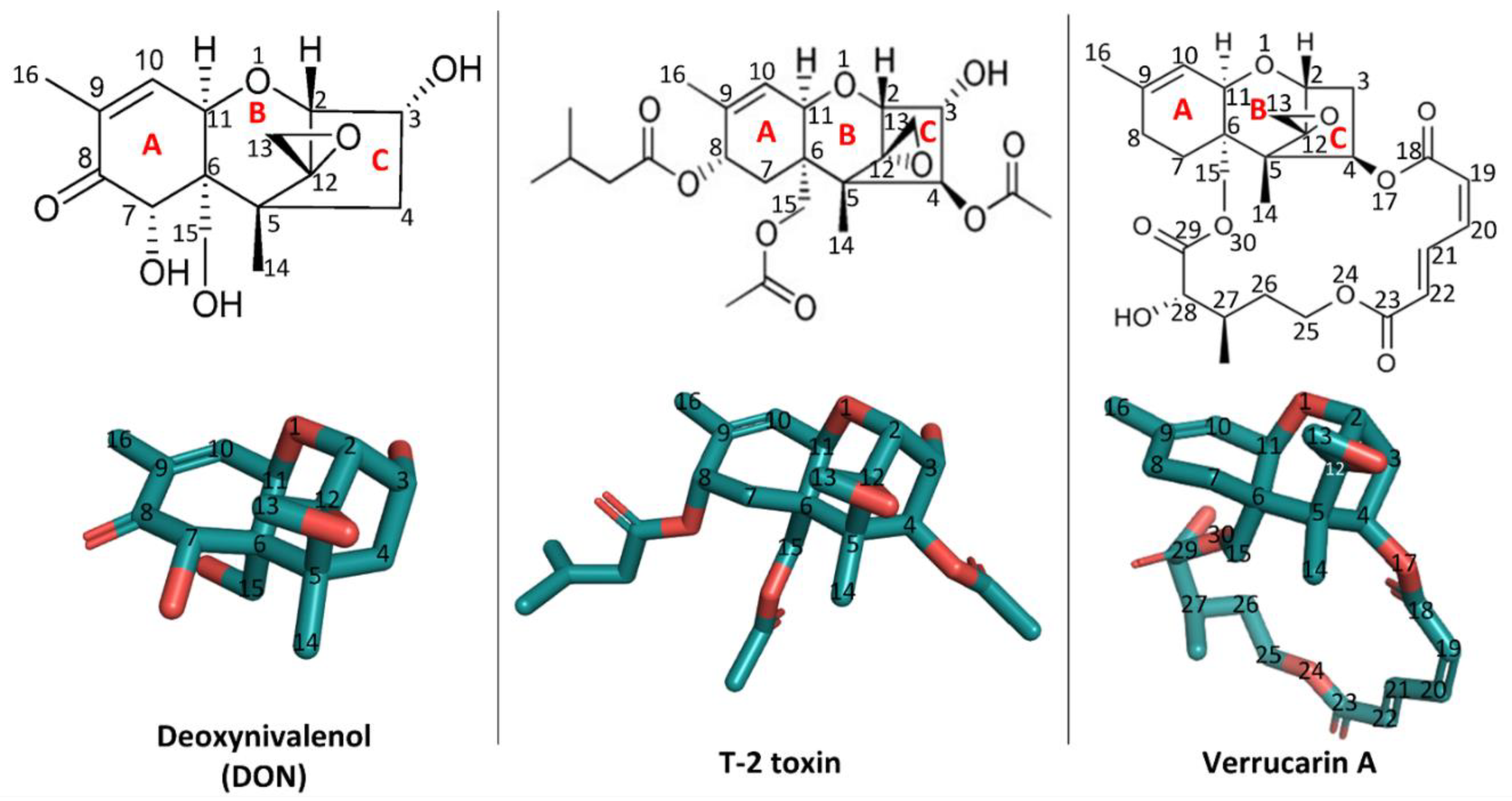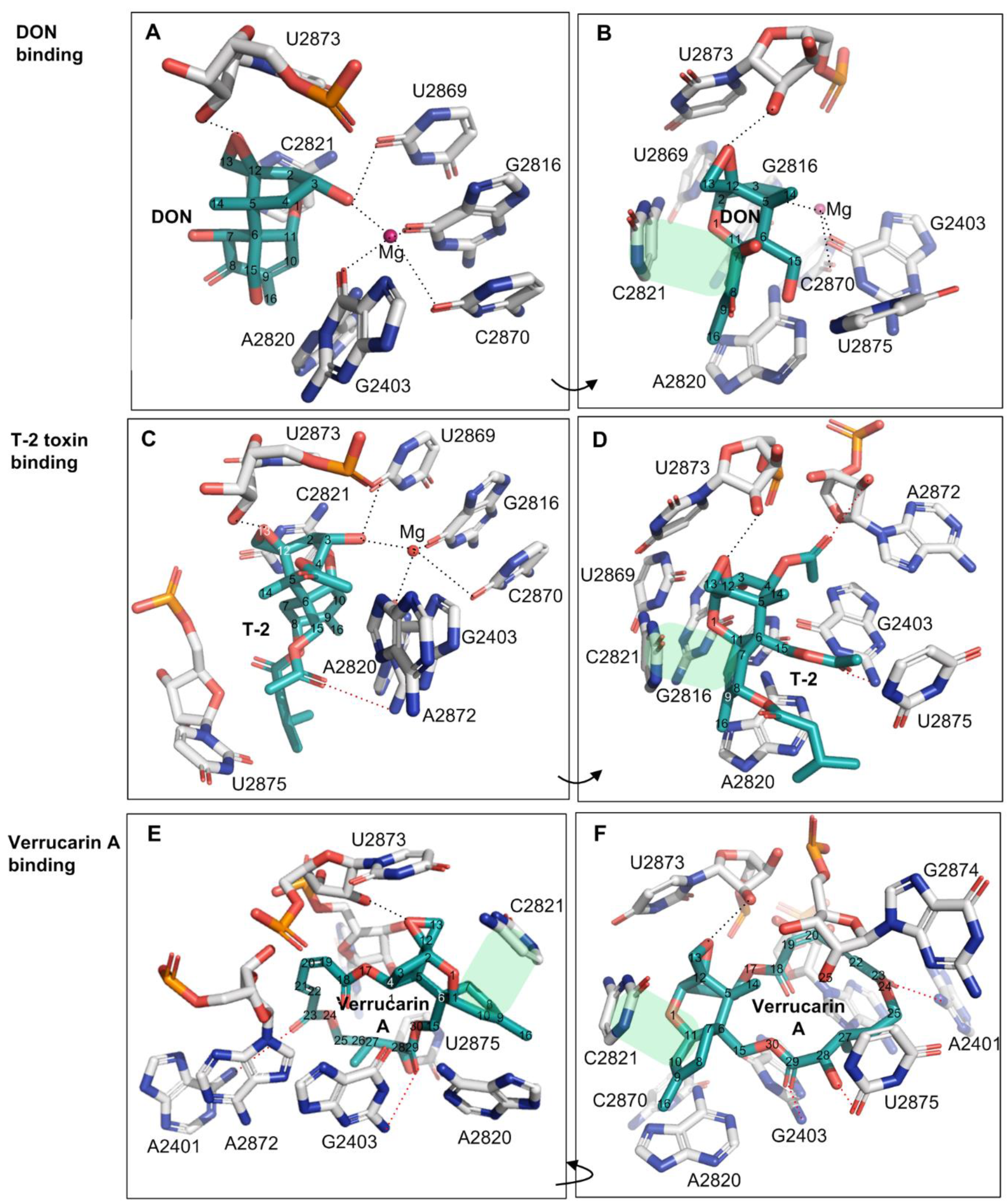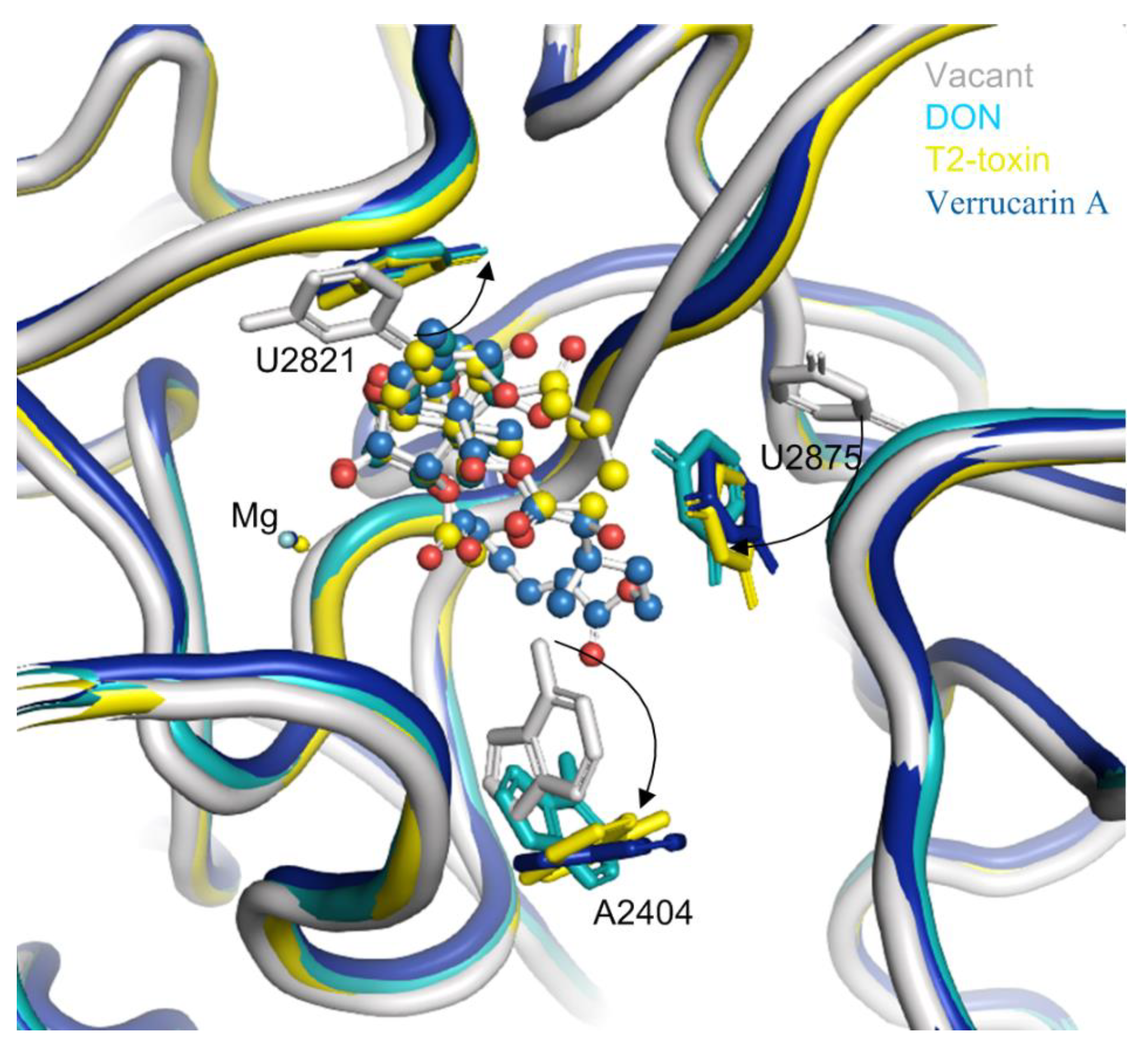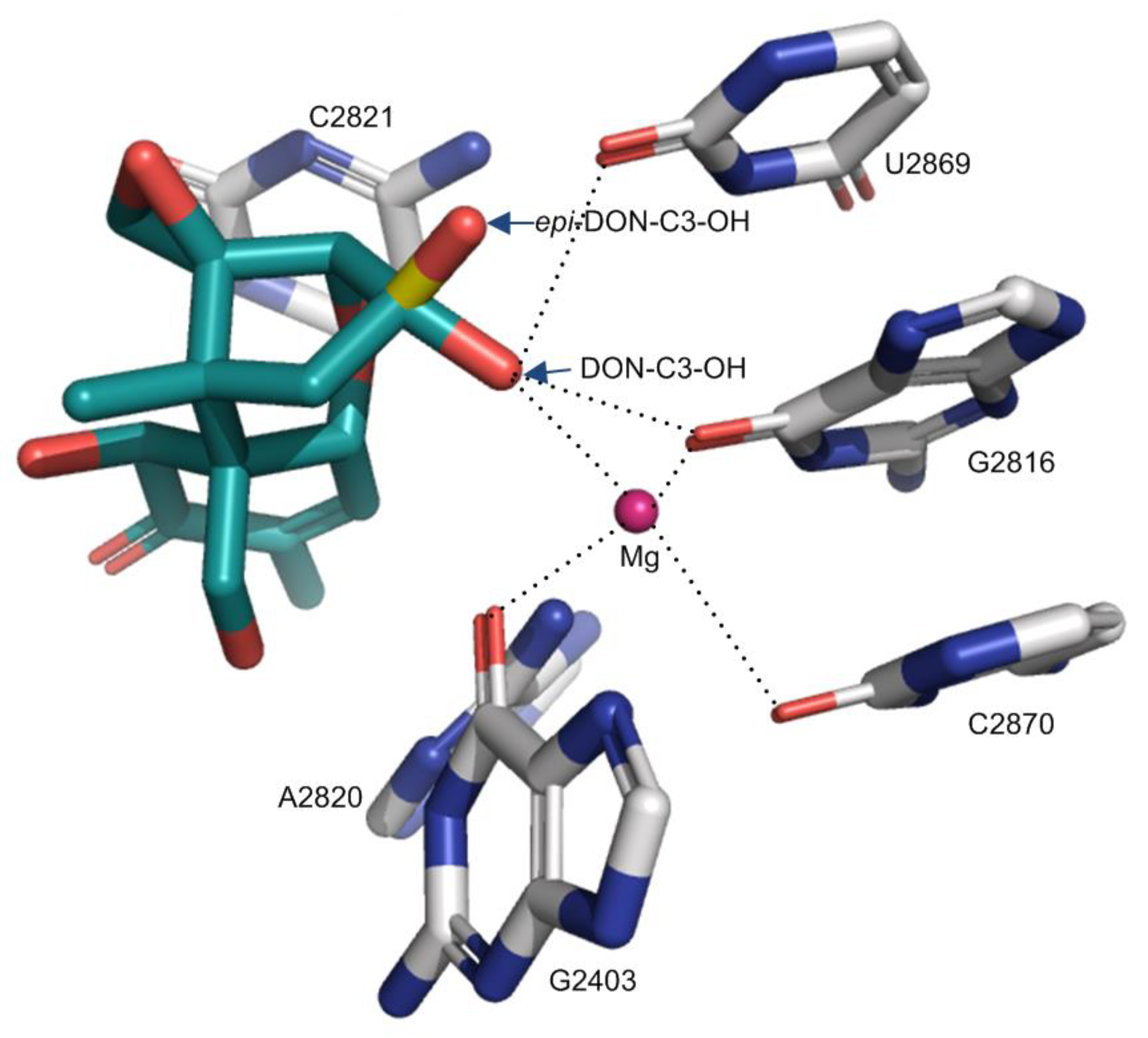The Ribosome-Binding Mode of Trichothecene Mycotoxins Rationalizes Their Structure—Activity Relationships
Abstract
1. Introduction
2. Results
2.1. The Multiple Interactions Involved in the Deoxynivalenol (DON) Binding to Yeast 80S Ribosome
2.2. The Substitutions of T-2 Toxin and Verrucarin A Introduced the New Contacts for Their Binding to the Ribosome
| Trichothecenes | Substitution Positions and Types | Substitution Type a | Cytotoxicity | References | ||||||
|---|---|---|---|---|---|---|---|---|---|---|
| C3 | C12,13 | C4 | C7 | C8 | C15 | Test Model | Relative IC50 b | |||
| Positions for Type II Substitution | Positions for Type I Substitution (C4, C7, C8, C15) | |||||||||
| DON | -OH | Epoxide | -H | -OH | =O | -OH | As a reference | - | 1.0 | |
| T-2 | -OH | Epoxide | -OAc | -H | -OCOCH2 CH (CH3)2 | -OAc | Type I | 3T3, Hep-G2, A549, HEp-2, Caco-2, A204, U937, Jurkat, RPMI8226, HUVEC | 0.002–0.023 | [33,34] |
| HT-2 | -OH | Epoxide | -OH | -H | -OCOCH2 CH (CH3)2 | -OAc | Type I | 3T3, Hep-G2, A549, HEp-2, Caco-2, A204, U937, Jurkat, RPMI8226, HUVEC | 0.011–0.046 | [33,34] |
| DAS | -OH | Epoxide | -OAc | -H | -H | -OAc | Type I | SF-9 insect cell | 0.011 | [36] |
| 15-Ac-DON | -OH | Epoxide | -H | -OH | =O | -OAc | Type I | 3T3, Caco-2 | 1.0–1.1 | [8,37] |
| Verrucarin A | -H | Epoxide | -OR | -H | -H | -OR | Type I | Vero, rat spleen lymphocytes | 0.004–0.008 | [35] |
| NIV | -OH | Epoxide | -OH | -OH | =O | -OH | Type I | 3T3 | 0.79 | [8] |
| 3-Ac-DON | -OAc | Epoxide | -H | -OH | =O | -OH | Type II | 3T3, Caco-2 | 2.1–10 | [8,37] |
| DON-3-GlcAc | -OGlcAc | Epoxide | -H | -OH | =O | -OH | Type II | K562 | >206 | [38] |
| DON-GSH | -OH | -GSH | -H | -OH | =O | -OH | Type II | n.d. c | n.d. | [30] |
| 3-epi-DON | -OH | Epoxide | -H | -OH | =O | -OH | NA d | 3T3, Caco-2 | 357–1181 | [39] |
| 3-keto-DON | =O | Epoxide | -H | -OH | =O | -OH | NA | 3T3, Caco-2 | 3.0–4.5 | [39] |
| DOM-1 | -OH | Epoxide | -H | -OH | =O | -OAc | NA | 3T3, chicken lymphocytes | 55–517 | [8,40] |
2.3. The Architecture of Trichothecenes Binding Pocket in Ribosome Impacts the Accommodation of Trichothecenes in Two Different Patterns
2.4. The Binding of Trichothecene Induced the Conformation Change of Several Nucleobases in 25S rRNA
3. Discussion
3.1. The Key Structural Elements Contributing to Trichothecenes Toxicity Play Critical Roles in the Binding to the Eukaryotic Ribosome
3.2. The Substitution Patterns of Trichothecenes Modulates the Binding to the Ribosome and Further Influence Their Toxicity
3.3. Implications of the Mechanism Behind Structure–Activity Relationships on the Development of Detoxification Strategies for Trichothecenes
4. Materials and Methods
4.1. Structure Analysis of Yeast 80S Ribosomes Complexed with Different Trichothecenes
4.2. Relative IC50 Values of Different Trichothecenes
5. Conclusions
Author Contributions
Funding
Data Availability Statement
Acknowledgments
Conflicts of Interest
Abbreviations
| FHB | Fusarium head blight disease |
| DON | Deoxynivalenol |
| DAS | Diacetoxyscirpenol |
| NIV | Nivalenol |
| OAc | Acetyl substituent |
| DON-3-Glc | Deoxynivalenol 3-glucoside |
| GSH | Glutathione |
References
- McCormick, S.P.; Stanley, A.M.; Stover, N.A.; Alexander, N.J. Trichothecenes: From simple to complex mycotoxins. Toxins 2011, 3, 802–814. [Google Scholar] [CrossRef] [PubMed]
- Pinton, P.; Oswald, I.P. Trichothecenes on the Intestine: A Review. Toxins 2014, 6, 1615–1643. [Google Scholar] [CrossRef]
- Proctor, R.H.; McCormick, S.P.; Kim, H.S.; Cardoza, R.E.; Stanley, A.M.; Lindo, L.; Kelly, A.; Brown, D.W.; Lee, T.; Vaughan, M.M.; et al. Evolution of structural diversity of trichothecenes, a family of toxins produced by plant pathogenic and entomopathogenic fungi. PLoS Pathog. 2018, 14. [Google Scholar] [CrossRef] [PubMed]
- Zhou, T.; He, J.; Gong, J. Microbial transformation of trichothecene mycotoxins. World Mycotoxin J. 2008, 1, 23–30. [Google Scholar] [CrossRef]
- Wu, Q.; Dohnal, V.; Kuca, K.; Yuan, Z. Trichothecenes: Structure-toxic activity relationships. Curr. Drug Metab. 2013, 14, 641–660. [Google Scholar] [CrossRef]
- Rocha, O.; Ansari, K.; Doohan, F.M. Effects of trichothecene mycotoxins on eukaryotic cells: A review. Food Addit. Contam. 2005, 22, 369–378. [Google Scholar] [CrossRef]
- Guerre, P. Mycotoxin and gut microbiota interactions. Toxins 2020, 12, 769. [Google Scholar] [CrossRef]
- Sundstøl Eriksen, G.; Pettersson, H.; Lundh, T. Comparative cytotoxicity of deoxynivalenol, nivalenol, their acetylated derivatives and de-epoxy metabolites. Food Chem. Toxicol. 2004, 42, 619–624. [Google Scholar] [CrossRef]
- Hassan, Y.I.; He, J.W.; Lepp, D.; Zhou, T. Understanding the bacterial response to mycotoxins: The transcriptomic analysis of deoxynivalenol-induced changes in devosia mutans 17-2-E-8. Front. Pharmacol. 2019, 10, 1–11. [Google Scholar] [CrossRef] [PubMed]
- Carere, J.; Hassan, Y.I.; Lepp, D.; Zhou, T. The identification of DepB: An enzyme responsible for the final detoxification step in the deoxynivalenol epimerization pathway in 17-2-E-8. Front. Microbiol. 2018, 9, 1–9. [Google Scholar] [CrossRef]
- Hassan, Y.I.; He, J.W.; Perilla, N.; Tang, K.J.; Karlovsky, P.; Zhou, T. The enzymatic epimerization of deoxynivalenol by Devosia mutans proceeds through the formation of 3-keto-DON intermediate. Sci. Rep. 2017, 7, 6929. [Google Scholar] [CrossRef] [PubMed]
- Pierron, A.; Mimoun, S.; Murate, L.S.; Loiseau, N.; Lippi, Y.; Bracarense, A.P.F.L.; Liaubet, L.; Schatzmayr, G.; Berthiller, F.; Moll, W.D.; et al. Intestinal toxicity of the masked mycotoxin deoxynivalenol-3-β-d-glucoside. Arch. Toxicol. 2016, 90, 2037–2046. [Google Scholar] [CrossRef] [PubMed]
- Poppenberger, B.; Berthiller, F.; Lucyshyn, D.; Sieberer, T.; Schuhmacher, R.; Krska, R.; Kuchler, K.; Glössl, J.; Luschnig, C.; Adam, G. Detoxification of the Fusarium mycotoxin deoxynivalenol by a UDP-glucosyltransferase from Arabidopsis thaliana. J. Biol. Chem. 2003, 278, 47905–47914. [Google Scholar] [CrossRef] [PubMed]
- Boutigny, A.L.; Richard-Forget, F.; Barreau, C. Natural mechanisms for cereal resistance to the accumulation of Fusarium trichothecenes. Eur. J. Plant Pathol. 2008, 121, 411–423. [Google Scholar] [CrossRef]
- Swanson, S.P.; Helaszek, C.; Buck, W.B.; Rood, H.D., Jr.; Haschek, W.M. The role of intestinal microflora in the metabolism of trichothecene mycotoxins. Food Chem Toxicol 1988, 26, 823–829. [Google Scholar] [CrossRef]
- Hussein, H.S.; Brasel, J.M. Toxicity, metabolism, and impact of mycotoxins on humans and animals. Toxicology 2001, 167, 101–134. [Google Scholar] [CrossRef]
- Arunachalam, C.; Doohan, F.M. Trichothecene toxicity in eukaryotes: Cellular and molecular mechanisms in plants and animals. Toxicol. Lett. 2013, 217, 149–158. [Google Scholar] [CrossRef]
- Abbas, H.K.; Yoshizawa, T.; Shier, W.T. Cytotoxicity and phytotoxicity of trichothecene mycotoxins produced by fusarium spp. Toxicon 2013, 74, 68–75. [Google Scholar] [CrossRef]
- Masuda, D.; Ishida, M.; Yamaguchi, K.; Yamaguchi, I.; Kimura, M.; Nishiuchi, T. Phytotoxic effects of trichothecenes on the growth and morphology of Arabidopsis thaliana. J. Exp. Bot. 2007, 58, 1617–1626. [Google Scholar] [CrossRef]
- Ueno, Y.; Hosoya, M.; Morita, Y.; Ueno, I.; Tatsuno, T. Inhibition of the protein synthesis in rabbit reticulocyte by nivalenol, a toxic principle from Fusarium nivale-growing rice. J. Biochem. 1968, 64, 479–484. [Google Scholar] [CrossRef]
- Cundliffe, E.; Cannon, M.; Davies, J. Mechanism of inhibition of eukaryotic protein synthesis by trichothecene fungal toxins. Proc. Natl. Acad. Sci. USA 1974, 71, 30–34. [Google Scholar] [CrossRef]
- Ehrlich, K.C.; Daigle, K.W. Protein synthesis inhibition by 8-oxo-12,13-epoxytrichothecenes. BBA Gen. Subj. 1987, 923, 206–213. [Google Scholar] [CrossRef]
- Garreau De Loubresse, N.; Prokhorova, I.; Holtkamp, W.; Rodnina, M.V.; Yusupova, G.; Yusupov, M. Structural basis for the inhibition of the eukaryotic ribosome. Nature 2014, 513, 517–522. [Google Scholar] [CrossRef] [PubMed]
- Pierron, A.; Mimoun, S.; Murate, L.S.; Loiseau, N.; Lippi, Y.; Bracarense, A.P.F.L.; Schatzmayr, G.; He, J.W.; Zhou, T.; Moll, W.D.; et al. Microbial biotransformation of DON: Molecular basis for reduced toxicity. Sci. Rep. 2016, 6, 29105. [Google Scholar] [CrossRef] [PubMed]
- Payros, D.; Alassane-Kpembi, I.; Pierron, A.; Loiseau, N.; Pinton, P.; Oswald, I.P. Toxicology of deoxynivalenol and its acetylated and modified forms. Arch. Toxicol. 2016, 90, 2931–2957. [Google Scholar] [CrossRef] [PubMed]
- Dellafiora, L.; Galaverna, G.; Dall’Asta, C. In silico analysis sheds light on the structural basis underlying the ribotoxicity of trichothecenes—A tool for supporting the hazard identification process. Toxicol. Lett. 2017, 270, 80–87. [Google Scholar] [CrossRef] [PubMed]
- Dellafiora, L.; Dall’Asta, C.; Galaverna, G. Toxicodynamics of mycotoxins in the framework of food risk assessment—an in silico perspective. Toxins 2018, 10, 52. [Google Scholar] [CrossRef]
- Abolmaali, S.; Mitterbauer, R.; Spadiut, O.; Peruci, M.; Weindorfer, H.; Lucyshyn, D.; Ellersdorfer, G.; Lemmens, M.; Moll, W.D.; Adam, G. Engineered bakers yeast as a sensitive bioassay indicator organism for the trichothecene toxin deoxynivalenol. J. Microbiol. Methods 2008, 72, 306–312. [Google Scholar] [CrossRef] [PubMed]
- McLaughlin, J.E.; Bin-Umer, M.A.; Tortora, A.; Mendez, N.; McCormick, S.; Tumer, N.E. A genome-wide screen in Saccharomyces cerevisiae reveals a critical role for the mitochondria in the toxicity of a trichothecene mycotoxin. Proc. Natl. Acad. Sci. USA 2009, 106, 21883–21888. [Google Scholar] [CrossRef] [PubMed]
- Moghbelli, H.; Ellithy, K.; Eslami, Z.; Vartanian, R.; Wannous, D.; El Ghamrawy, A.; Basha, O.; Fayad, A.; Qaraqe, M.; Nicola, S.; et al. Horizontal gene transfer of Fhb7 from fungus underlies Fusarium head blight resistance in wheat. Science 2020, 21, 1–9. [Google Scholar] [CrossRef]
- Petrov, A.S.; Bernier, C.R.; Hsiao, C.; Norris, A.M.; Kovacs, N.A.; Waterbury, C.C.; Stepanov, V.G.; Harvey, S.C.; Fox, G.E.; Wartell, R.M.; et al. Evolution of the ribosome at atomic resolution. Proc. Natl. Acad. Sci. USA 2014, 111, 10251–10256. [Google Scholar] [CrossRef]
- Mears, J.A.; Cannone, J.J.; Stagg, S.M.; Gutell, R.R.; Agrawal, R.K.; Harvey, S.C. Modeling a minimal ribosome based on comparative sequence analysis. J. Mol. Biol. 2002, 321, 215–234. [Google Scholar] [CrossRef]
- Nielsen, C.; Casteel, M.; Didier, A.; Dietrich, R.; Märtlbauer, E. Trichothecene-induced cytotoxicity on human cell lines. Mycotoxin Res. 2009, 25, 77–84. [Google Scholar] [CrossRef] [PubMed]
- Widestrand, J.; Lundh, T.; Pettersson, H.; Lindberg, J.E. A rapid and sensitive cytotoxicity screening assay for trichothecenes in cereal samples. Food Chem. Toxicol. 2003, 41, 1307–1313. [Google Scholar] [CrossRef]
- Thompson, W.L.; Wannemacher, R.W. Structure-function relationships of 12,13-epoxytrichothecene mycotoxins in cell culture: Comparison to whole animal lethality. Toxicon 1986, 24, 985–994. [Google Scholar] [CrossRef]
- Fornelli, F.; Minervini, F.; Logrieco, A. Cytotoxicity of fungal metabolites to lepidopteran (Spodoptera frugiperda) cell line (SF-9). J. Invertebr. Pathol. 2004, 85, 74–79. [Google Scholar] [CrossRef] [PubMed]
- Alexander, N.J.; McCormick, S.P.; Waalwijk, C.; van der Lee, T.; Proctor, R.H. The genetic basis for 3-ADON and 15-ADON trichothecene chemotypes in Fusarium. Fungal Genet. Biol. 2011, 48, 485–495. [Google Scholar] [CrossRef]
- Wu, X.; Murphy, P.; Cunnick, J.; Hendrich, S. Synthesis and characterization of deoxynivalenol glucuronide: Its comparative immunotoxicity with deoxynivalenol. Food Chem. Toxicol. 2007, 45, 1846–1855. [Google Scholar] [CrossRef] [PubMed]
- He, J.W.; Bondy, G.S.; Zhou, T.; Caldwell, D.; Boland, G.J.; Scott, P.M. Toxicology of 3-epi-deoxynivalenol, a deoxynivalenol-transformation product by Devosia mutans 17-2-E-8. Food Chem. Toxicol. 2015, 84, 250–259. [Google Scholar] [CrossRef]
- Novak, B.; Vatzia, E.; Springler, A.; Pierron, A.; Gerner, W.; Reisinger, N.; Hessenberger, S.; Schatzmayr, G.; Mayer, E. Bovine peripheral blood mononuclear cells are more sensitive to deoxynivalenol than those derived from poultry and swine. Toxins 2018, 10, 152. [Google Scholar] [CrossRef]
- Leshin, J.A.; Heselpoth, R.; Belew, A.T.; Dinman, J.D. High throughput structural analysis of yeast ribosomes using hSHAPE. RNA Biol. 2011, 8, 478–487. [Google Scholar] [CrossRef] [PubMed][Green Version]
- Desjardins, A.E.; McCormick, S.P.; Appell, M. Structure-activity relationships of trichothecene toxins in an Arabidopsis thaliana leaf assay. J. Agric. Food Chem. 2007, 55, 6487–6492. [Google Scholar] [CrossRef]
- Hassan, Y.I.; Watts, C.; Li, X.Z.; Zhou, T. A novel peptide-binding motifs inference approach to understand deoxynivalenol molecular Toxicity. Toxins 2015, 7, 1989–2005. [Google Scholar] [CrossRef]
- Gao, X.; Mu, P.; Wen, J.; Sun, Y.; Chen, Q.; Deng, Y. Detoxification of trichothecene mycotoxins by a novel bacterium, Eggerthella sp. DII-9. Food Chem. Toxicol. 2018, 112, 310–319. [Google Scholar] [CrossRef]
- He, W.J.; Shi, M.M.; Yang, P.; Huang, T.; Yuan, Q.S.; Yi, S.Y.; Wu, A.B.; Li, H.P.; Gao, C.B.; Zhang, J.B.; et al. Novel soil bacterium strain desulfitobacterium sp. PGC-3-9 detoxifies trichothecene mycotoxins in wheat via de-epoxidation under aerobic and anaerobic conditions. Toxins 2020, 12, 363. [Google Scholar] [CrossRef]
- Islam, R.; Zhou, T.; Young, J.C.; Goodwin, P.H.; Pauls, K.P. Aerobic and anaerobic de-epoxydation of mycotoxin deoxynivalenol by bacteria originating from agricultural soil. World J. Microbiol. Biotechnol. 2012, 28, 7–13. [Google Scholar] [CrossRef]
- Carere, J.; Hassan, Y.I.; Lepp, D.; Zhou, T. The enzymatic detoxification of the mycotoxin deoxynivalenol: Identification of DepA from the DON epimerization pathway. Microb. Biotechnol. 2018, 11, 1106–1111. [Google Scholar] [CrossRef] [PubMed]
- Zhu, Y.; Hassan, Y.I.; Lepp, D.; Shao, S.; Zhou, T. Strategies and methodologies for developing microbial detoxification systems to mitigate mycotoxins. Toxins 2017, 9, 130. [Google Scholar] [CrossRef] [PubMed]
- Fuchs, E.; Binder, E.M.; Heidler, D.; Krska, R. Characterisation of metabolites after the microbial degradation of A- and B-trichothecenes by BBSH 797. Mycotoxin Res. 2000, 16, 66–69. [Google Scholar] [CrossRef]
- Li, X.Z.; Zhu, C.; de Lange, C.F.M.; Zhou, T.; He, J.; Yu, H.; Gong, J.; Young, J.C. Efficacy of detoxification of deoxynivalenol-contaminated corn by Bacillus sp. LS100 in reducing the adverse effects of the mycotoxin on swine growth performance. Food Addit. Contam.—Part A Chem. Anal. Control. Expo. Risk Assess. 2011, 28, 894–901. [Google Scholar] [CrossRef]
- Ikunaga, Y.; Sato, I.; Grond, S.; Numaziri, N.; Yoshida, S.; Yamaya, H.; Hiradate, S.; Hasegawa, M.; Toshima, H.; Koitabashi, M.; et al. Nocardioides sp. strain WSN05-2, isolated from a wheat field, degrades deoxynivalenol, producing the novel intermediate 3-epi-deoxynivalenol. Appl. Microbiol. Biotechnol. 2011, 89, 419–427. [Google Scholar] [CrossRef] [PubMed]
- Stanic, A.; Uhlig, S.; Solhaug, A.; Rise, F.; Wilkins, A.L.; Miles, C.O. Nucleophilic addition of thiols to deoxynivalenol. J. Agric. Food Chem. 2015, 63, 7556–7566. [Google Scholar] [CrossRef] [PubMed]





| Trichothecenes | Atom in Trichothecenes (underlined) | Ribosome Residue/Metal Ion | Interaction Type | Distance(Å) | Comments |
|---|---|---|---|---|---|
| DON Bound in 25S rRNA | |||||
| DON | C3-OH | Mg2+ | Metal ion coordination * | 2.7–2.9 | Binding contacts contributed by C3-OH |
| C3-OH | O2-U2869 | Hydrogen bond * | 2.7–3.2 | ||
| O-C12,13-epoxide | HO2′-β-ribose-U2873 | Hydrogen bond * | 2.5–2.8 | Binding contacts formed by the core structure elements to the toxicity of trichothecenes | |
| C6,7,8,9,10,11 ring, along with C16 methyl | Cytosine ring in C2821 | Hydrophobic stacking interaction | NA | ||
| C6,7,8,9,10,11 ring, along with C16 methyl | Adenine ring in A2820 | Edge-to-edge hydrophobic interaction | NA | ||
| T-2 | C3-OH | Mg2+ | Metal ion coordination | 2.6 | Binding contacts contributed by C3-OH |
| C3-OH | O2-U2869 | Hydrogen bond | 2.9 | ||
| O-C12,13-epoxide | HO2′-β-ribose-U2873 | Hydrogen bond | 2.7 | Binding contacts formed by the core structure elements to the toxicity of trichothecenes | |
| C6,7,8,9,10,11 ring, along with C16 methyl | Cytosine ring in C2821 | Hydrophobic stacking interaction | NA | ||
| C6,7,8,9,10,11 ring, along with C16 methyl | Adenine ring in A2820 | Hydrophobic edge-to-edge interaction | NA | ||
| O-C4-OAc | HO2′-β-ribose-U2872 | hydrogen bond | 3.1 | Additional contacts contributed by the substituents of T-2 toxin | |
| CH3-C4-OAc | G2403 and A2872 | Hydrophobic interaction | NA | ||
| O1-C15-OAc | HN2-G2403 | hydrogen bond | 3.4 | ||
| [OCOCH2CH(CH3)2]-C8- | A2820 and U2875 | Hydrophobic interaction | NA | ||
| Verrucarin A | |||||
| O-C12,13-epoxide | HO2′-β-ribose-U2873 | Hydrogen bond | 2.8 | Binding contacts formed by the core structure elements to the toxicity of trichothecenes | |
| C6,7,8,9,10,11 ring, along with C16 methyl | Cytosine ring in C2821 | Hydrophobic stacking interaction | NA | ||
| C6,7,8,9,10,11 ring, along with C16 methyl | Adenine ring in A2820 | Edge-to-edge hydrophobic interaction | NA | ||
| Additional ring between C4 and C15 | ribose bases of A2872, U2873 and G2874 | hydrophobic interaction | NA | Additional contacts contributed by the substituents of verrucarin A | |
| O-C29-ketone | HN2-G2403 | Hydrogen bond | 3.4 | ||
| OH-C28 | O2-U2875 | Hydrogen bond | 2.6 | ||
| O-C23-ketone | HN6-A2401 | Weak hydrogen bond | 3.7 | ||
Publisher’s Note: MDPI stays neutral with regard to jurisdictional claims in published maps and institutional affiliations. |
© 2021 by the authors. Licensee MDPI, Basel, Switzerland. This article is an open access article distributed under the terms and conditions of the Creative Commons Attribution (CC BY) license (http://creativecommons.org/licenses/by/4.0/).
Share and Cite
Wang, W.; Zhu, Y.; Abraham, N.; Li, X.-Z.; Kimber, M.; Zhou, T. The Ribosome-Binding Mode of Trichothecene Mycotoxins Rationalizes Their Structure—Activity Relationships. Int. J. Mol. Sci. 2021, 22, 1604. https://doi.org/10.3390/ijms22041604
Wang W, Zhu Y, Abraham N, Li X-Z, Kimber M, Zhou T. The Ribosome-Binding Mode of Trichothecene Mycotoxins Rationalizes Their Structure—Activity Relationships. International Journal of Molecular Sciences. 2021; 22(4):1604. https://doi.org/10.3390/ijms22041604
Chicago/Turabian StyleWang, Weijun, Yan Zhu, Nadine Abraham, Xiu-Zhen Li, Matthew Kimber, and Ting Zhou. 2021. "The Ribosome-Binding Mode of Trichothecene Mycotoxins Rationalizes Their Structure—Activity Relationships" International Journal of Molecular Sciences 22, no. 4: 1604. https://doi.org/10.3390/ijms22041604
APA StyleWang, W., Zhu, Y., Abraham, N., Li, X.-Z., Kimber, M., & Zhou, T. (2021). The Ribosome-Binding Mode of Trichothecene Mycotoxins Rationalizes Their Structure—Activity Relationships. International Journal of Molecular Sciences, 22(4), 1604. https://doi.org/10.3390/ijms22041604







